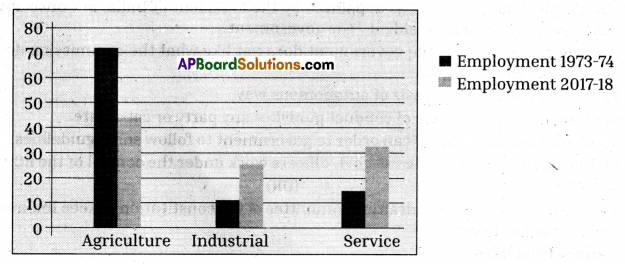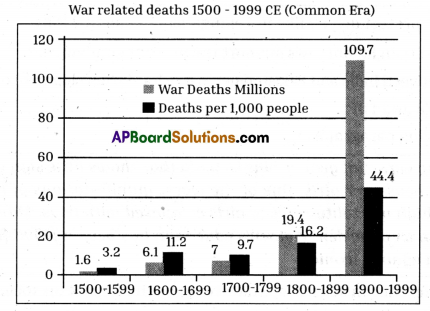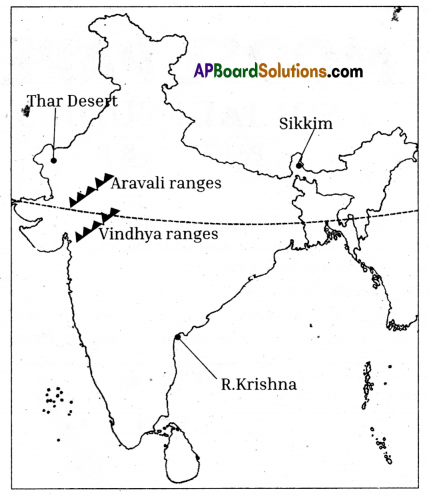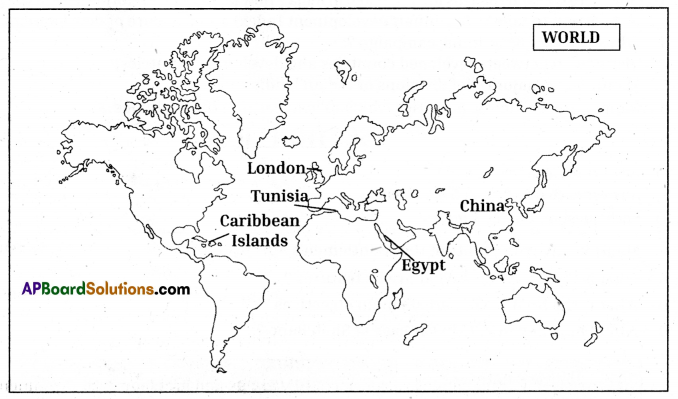Thoroughly analyzing TS 10th Class Social Model Papers Set 6 with Solutions helps students identify their strengths and weaknesses.
TS 10th Class Social Model Paper Set 6 with Solutions
Time: 3 hours
Max. Marks:80
Instructions:
- Read the questions carefully, understand them and answer.
- Write the answers for the questions in Part – A in the answer sheet.
- Attach the Map to Part – A answer sheet.
- Attach Part – B to Part A answer sheet.
- Part – A consists of I, II and III Sections.
- Write the answers clearly duly following the instructions given for each section.
Part-A (Marks 60)
Section-I (6 x 2 = 12M)
1. Answer all questions.
2. Answer each question in 3-4 sentences.
3. Each question carries 2 marks.
Question 1.
Which qualities of Lal Bahadur Shastri do you like? Why?
Answer:
I like Lai Bahadur Shastri’s qualities. The Unity of the Nation came first over his personal standpoints. Why because, the Prime Minister went out of their way to ensure that things were within control despite not being personally in favour of the stand by the agitations.
Question 2.
What does the ‘sink function’ describe?
Answer:
The “sink function” describes an environment’s ability to absorb and render harmless waste and pollution. When waste output exceeds the limit of the sink function, long-term damage to the environment occurs.
Question 3.
Why did the small and poor peasants start an agitation in Bengal?
Answer:
An agitation was started in Bengal by small and poor peasants who took land of the bigger landowners to cultivate. They demanded that their share of harvest should be increased to two portions out of three instead of half or even less, that was given to them at that time. This was called the Tebhaga movement and was led by the Provincial Kisan Sabha.
![]()
Question 4.
What are the factors that helped Himachal Pradesh in achieving a better literacy rate?
Answer:
- Both the government of Himachal Pradesh and the people of the state were keen on education.
- The government started schools and made sure that education was largely free, or costs very little for parents.
- Further, it tried to ensure that these schools had at least the minimum facilities of teachers, classrooms, toilets, drinking water, etc.
- Among the Indian states, Himachal Pradesh has the distinction of one of the highest spending from the government budget on education for each child.
Question 5.
Differentiate Eastern ghats and Western ghats.
Answer:
| Western ghats | Eastern ghats |
| 1) These lie parallel to the West Coast. | 1) These lie parallel to the East Coast. |
| 2) These are continuous. | 2) These are not continuous. |
| 3) These extend for 1600 kms. | 3) The average height is 900 mts. |
| 4) Highest peak in Western Ghats is Anaimudi. | 4) Highest peak in Eastern Ghats is Aromakonda. |
Question 6.
Explain ‘Multiple Cropping’ in your own words.
Answer:
Growing more than one crop on a piece of land during the year is known as multiple cropping. It is the most common and traditional practice to increase production on a given piece of land. All farmers in Rampur grow at least two main crops.
Section – II (6 x 3 = 18M)
1. Answer all questions.
2. Answer each question in 5-6 sentences.
3. Each question carries 3 marks.
Question 7.
Which forms of protest do you like in Telangana movement? Why?
Answer:
Forms of protest in Telangana movement:
- Dhoom-dhams
- Padayathra
- Assembly muttadi
- Million March
- Sagaraharam
- Garjanas
- Sadakbandh
- Bonalu
- Sakala Janula Sam me
Question 8.
How can flexibility in labour laws support the present companies?
Answer:
- Flexibility in labour laws help companies to reduce the cost of labour for the company by negotiating the wages and other conditions.
- For example, instead of hiring workers on a regular basis, companies hire workers ‘flexibly’ for short periods when there is intense, pressure of work.
- Companies can offer good salaries for worthy labour and terminate unuseful labour.
- Government has also allowed flexibility in the labour laws to attract foreign investment.
- Labour laws protect the interests of labour with guaranteed jobs, security in jobs. But rigid labour laws hinder the growth of companies with too many restrictions.
Question 9.
Why is peace between India and Pakistan necessary for the development of both the countries?
Answer:
- Both India and Pakistan have nuclear status and in this scenario the need of peace process between them is much more important than ever before.
- Any kind of conventional armed conflict can change into a nuclear war.
- So, the peace process should be based on development of both the countries.
- For social, political and- economical development of the both the countries, peace should be established between them.
Question 10.
Write about NTR and TDP.
Answer:
N.T. Rama Rao (NTR), popular film actor, began the Telugu Desam Party (TDP) on his 60th birthday in 1982. He said that the TDP stood for the honour and self-respect of the Telugu-speaking people (Teluguvari atma gauravam). He argued that the State could not be treated as a lower office of the Congress party. Equally important were his promise of some very important welfare measures for the poor including mid-day meal scheme in government schools, sale of rice at Rs. 2 per Kg to the poor and liquor prohibition. These populist measures helped the TDP to sweep the 1982 elections. However, he was surreptitiously dismissed by the Governor in 1984 when he was away in the United States for a surgery.
![]()
Question 11.
Read the following paragraph.
A distressing aspect of gender bias in India that shows little sign of going away is the preference for boys over girls. One of the worst manifestations of this promise bias is the relatively high mortality rates of girls compared with boys. Many families consider female children as a burden. Women’s education has been a powerful force in reducing discrimination against women. “Due to the difference In sex ratio, what would be the impact on society ?“ Explain.
Answer:
- Female population will decrease.
- In future male population may not get marriages.
- Family system may collapse.
- Gender bias may increase in the society.
- The problem of criminality in our society will increase.
Question 12.
Read the following passage and answer the given questions.
India lies in the trade wind belt of Northern Hemisphere – north-east trades blow over India from land to sea and are, therefore, dry. however, some amount of rainfall occurs on the Coromandel coast of Tamil Nadu from these winds, as they pick up moisture from the Bay of Bengal while crossing it.
i) Match the following.
i) India A. Bay of Bengal
ii) North-east trades B. Tamil Nadu
iii) Coromandel coast C. Northern hemisphere
Answer:
i) C
ii) A
iii) B
ii) India lies in the trade wind belt of Northern Hemisphere
iii) The Bay of Bengal
iv) North-east trades blow over India from land to sea and are therefore dry.
v) East coast has tghe Coramandal coast.
Section – III (6 x 5 = 30M)
1. Answer all questions
2. There is an internal choice for each question.
3. Answer each question in 8-10 sentences.
4. Each question carries 5 marks.
Question 13.
A) Write about the availability of food materials in India.
(OR)
B) Find out about the issues which “Green peace” have been fighting for and how the methods they have used for fighting.
Answer:
A)
1. Availability of food materials involves two aspects.
- Sufficient production of food grains.
- Access to minimum consumption. Food material means food grains like paddy, wheat, jowar, oil seeds and other food items like fruits, vegetables, milk, meat, poultry and fisheries.
2. The food material like paddy, wheat, jowar and oil seeds are available to public in the following ways:
- Public Distribution System like ration shops where people go and buy foodgrains at subsidised prices.
- Mid-day meals and anganwadis where children are taken care of.
- General shops.
3. Through Green Revolution, the grains production has increased.
4. The foodgrains are made available through .
- good increase in the crop yield,
- imports,
- change in the government stocks to meet the people’s demands.
5. There is a good sign of consumers and producers for other food items also.
6. As per National Food Security Act 2013, the Right to Food is legalised. Accordingly, the government is providing food grains and nutritious food.
(OR)
B)
- Greenpeace takes on Europe’s biggest car maker and wins.
- Greenpeace welcomes Sealord’s promise to end destructive Tuna fishing.
- Greenpeace supports the Stockholm Convention on persistent organic pollutants such as DDT. However, both the Stockholm Convention and Greenpeace allow DDT to be used for Malaria control.
Methods of dealing with issues:
- Greenpeace uses direct action, lobbying and research to achieve its goals.
- It does not accept funding from governments, corporates or political parties.
- It gets its support from 2.9 million individual supporters and foundation grants.
- It has a general consultative status with UNESCO.
- It stresses on developing, accountability and transparency of non-governmental organizations.
Question 14.
A) Draw the bar graph on the basis of information given in the table below.
Employment in three sectors
| Sector | Employment (%) | |
| 1973-74 | 2017-18 | |
| Agriculture | 74 | 44 |
| Industrial | 11 | 25 |
| Service | 15 | 31 |
(OR)
B) Read the following para and answer the question given below.
“No proper mining standards are followed in iron ore extraction. The mining of iron ore at Kudremukh and manganese in Sandur has seriously affected the stability of the catchments in the form of soil erosion and siltation of several small reservoirs, traditional tanks and Tun Gabhadra reservoir.” Why is the availability of minerals more in river basins? What are the problems caused by the extraction of mines?
Answer:

(OR)
B) Availability of minerals in river basins:
- Generally, rivers are born in mountains or hills and flow downwards.
- In its direction of flow, it forms fertile plains and merges with sea.
- In this process, rivers bring many minerals along with water and deposit them in the plains.
- So, the availability of minerals is more in a river basin.
Problems caused by the extraction of minerals:
- In the process of extraction of minerals, we should face many problems.
- Soil erosion will be increased due to extraction of minerals.
- Due to soil erosion, rivers are filled with sand which leads to sudden floods.
- The river water gets polluted.
- Many environmental problems will be raised.
- Health problems will be caused to the surrounding people.
![]()
Question 15.
A) Observe the graph and answer the questions given under.

i) How many people were died in wars in between 1500 – 1599, i.e., 16th century.
ii) What was the number of war deaths in 20th century?
iii) What was the number of war deaths in 18” century?
iv) How many persons were killed per 1,000 people at war in 20th century?
v) Why were the war deaths so high in the last century?
(OR)
B) Freedom struggle in these countries involved wars against the rulers. Briefly describe its impact.
Answer:
A)
i) 3.2 million people were died.
ii) Around 4.4% i.e., 44 per 1,000.
iii) 9.7% persons were died in war per 1,000 people in 18th century.
iv) 44.4 percentage at an average per 1,000 people.
v) The previous wars between nations were not geographically widespread nor were their effects as lethal as the ones in the 20th century.
(OR)
B) China:
- In China, both parties Guomindang and Chinese Communist Party (CCP) joined forces and fought with Japan.
- The People’s Republic of China government was established in 1949. It was based on the principles of the ‘New Democracy’.
- Critical areas of the economy were put under government control.
- C.C.P. undertook many land reform measures.
- New laws were enacted to protect women and their rights.
Nigeria:
- The freedom fighters united the military to fight against the colonial British rulers.
- The radicalised nationalism made British to yield to it.
- Corruption and suppression of human rights appeared everywhere. In military regime, the multinational oil corporations funded the corrupt rulers.
In all these countries, valuable natural resources like oil wells in Nigeria, forests in Vietnam were damaged and destroyed. Due to wars, the economies of these countries were very weak leaving an impact of unrest after they got independence.
Question 16.
A) How can we say that Indian Election Commission is considered as independent authority (autonomous body)?
(OR)
B) What are the means adopted by the drafting committee of the constitution to keep India as a Federation and at the same time to maintain the unity of the country? (Or) Distinguish between federal and unitary systems.
Answer:
A) According to the constitution election commission is considered as independent authority/autonomous body. The CEC is appointed by the President of India. But once appointed, he is not answerable to the President /the government.
- Even ruling party or the government does not like what the commission does impossible for it to remove the CEC.
- It takes decisions on basis of autonomous way.
- It implements the code of conduct punishes any party or candidate.
- In election time, the EC can order to government to follow some guidelines.
- During the eléction time the govt. officers work under the control of the EC.
(OR)
B) The means adopted by the drafting committee of the constitution to keep India as a Federation and to maintain unity:
Unitary Principles:
- Supremacy of the Constitution.
- Supremacy of the Central Polity.
- Single Judiciary.
- Uniformity in fundamental laws.
- Common All India Civil Service.
- Single Citizenship.
Federal principles:
- Dual polity.
- Union of states.
- Right to form their own Civil Services.
- States are not mere administrative units of the Central Government.
Question 17.
A) How does the urban settlements contribute to India’s economic development?
(OR)
B) Read the following paragraph and write your opinion on it.
We are already experiencing the negative consequences of rapaid economic growth on several fronts – the problem of groundwater and pesticides being two stark examples. We have several thousands of communities living The Environment. To destroy The environment means to destroy these communities.
Answer:
A)
- Service sector activities such as finance, insurance, real estate and business-related service activities such as transport, storage and communication contribute more than industrial activities.
- Most of the poor live in non-metropolitan towns, work in the unorganized sector.
- Most of the public enterprises are either located in urban settlements or in their surroundings.
- Most of the state of art equipment is located in urban settlements. ,
- Most of the Information Technology industries or parks are operating in urban areas.
- The exports of many of these contribute a lot to GDP of our country.
- Thus, the urban settlements contribute to India’s economic development.
(OR)
B)
- The idea of development has been contested through problems of environment.
- The groundwater levels fell rapidly and groundwater recharge is also not to the expected level.
- Fertilizers made the soil less fertile and ever-increasing costs to farmers.
- Industrialisation has resulted in a world where natural resources are threatened.
My Opinion: Always we should be able to integrate environmental concerns with the idea of progress, along with issues of equity and justice. We have to find an environmentally sustainable pathway out of poverty.in GDP and modern industrial development are necessary.
Question 18.
A) Locate the following in the given outline map of India.
a)
i) Vindhya Ranges
ii) Krishna River
iii) Sikkim
iv) Thar Desert
v) Aravalis
(OR)
B) Locate the following in World Map:
i) China
ii) Egypt
iii) Tunisia
iv) London
v) Caribbean Islands
Answer:

(Or)

Part – B (20 Marks)
Instructions:
- Answer all questions.
- Choose the correct option from the given four Options and write the letter (A to B or C or D) in CAPITAL LETTER in the brackets.
- Each question carries 1 mark.
- Write the answers in the question paper itself.
- Marks are not given to corrected, dismissed or erased answers.
Question 1.
The Northern most range of Greater Himalayas are also known as ( )
A) Himachal
B) Shivalik
C) Himadri
D) Purvanchal
Answer:
B) Shivalik
![]()
Question 2.
A part of the land is under ……………………. which is harvested once every year. ( )
A) cloves
B) sugarcane
C) millets
D) mirchi
Answer:
B) sugarcane
Question 3.
Telangana agitation, a counter-movement started in ………………….. in the Seemandhra regions called Jal Andhra. ( )
A) 1972
B) 1973
C) 1974
D) 1975
Answer:
A) 1972
Question 4.
An MNC owns and controls production in ( )
A) Only one nation
B) More than one nation
C) Only in one state
D) More than one state
Answer:
B) More than one nation
Question 5.
Fidayeens (suicide squads) was formed in ( )
A) Palestine
B) Israel
C) Egypt
D) Lebanon
Answer:
C) Egypt
Question 6.
The first coalition government was formed by V.P. Singh. ( )
A) Akali Dal
B) T.D.P
C) D.M.K
D) Janata Dal
Answer:
D) Janata Dal
Question 7.
………………… is a key for socio-economic progress. ( )
A) sex ratio
B) minority
C) literacy
D) voting
Answer:
C) literacy
Question 8.
India gets highest rainfall with the influence of ………………….. .( )
A) South-West monsoons
B) North-East monsoons
C) Local winds
D) All the above
Answer:
A) South-West monsoons
Question 9.
B.M.I. means ( )
A) Body Mass Index
B) Body Measure Index
C) Body Minimum Index
D) Body Maximum Index.
Answer:
A) Body Mass Index
Question 10.
Vietnamese use …………………. warfare techniques to fight the war. ( )
A) Artillery
B) Nuclear
C) Guerilla
D) Uranium
Answer:
C) Guerilla
![]()
Question 11.
Economic activities are divided into sectors. ( )
A) two
B) three
C) four
D) five
Answer:
B) three
Question 12.
…………………. is being mined at in Sandur. ( )
A) Manganese
B) Copper
C) Coal
D) Led
Answer:
A) Manganese
Question 13.
Great economic depression occurred in ……………………. A.D. ( )
A) 1927
B) 1928
C) 1929
D) 1930
Answer:
C) 1929
Question 14.
Leader of NYM(Nigerian Youth Movement) was ( )
A) Azikiwe
B) Mao
C) Chiang
D) None
Answer:
A) Azikiwe
Question 15.
NOTA first introduced as an option in the state of (‘ )
A) Andhra Pradesh
B) Maharashtra
C) Goa
D) Delhi
Answer:
D) Delhi
Question 16.
The council also ensured that ……………….. members from Scheduled Castes are represented in the Assembly. ( )
A) 24
B) 25
C) 26
D) 27
Answer:
C) 26
Question 17.
Which one of the following is NOT an aerotrop oils? ( )
A) Delhi
B) Mumbai
C) Vijayawada
D) Hyderabad
Answer:
C) Vijayawada
Question 18.
Social indicators of education and health are included in ( )
A) GDP
B) Per Capita Income
C) GNP
D) HDI
Answer:
D) HDI
Question 19.
‘Sare Jahan Se Achha’ song was written by ( )
A) Md. Iqbal
B) Md. Mi Zinnah
C) Moulana Azad
D) None
Answer:
A) Md. Iqbal
![]()
Question 20.
Sri Lanka is much ahead of ………………………. in every respect. ( )
A) Russia
B) USA
C) India
D) None
Answer:
C) India